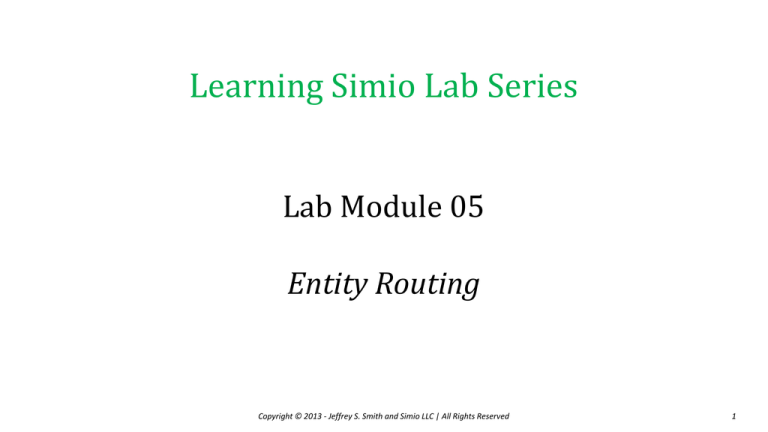
Learning Simio Lab Series
Lab Module 05
Entity Routing
Copyright © 2013 - Jeffrey S. Smith and Simio LLC | All Rights Reserved
1
Objectives and Outline
• Lab Objectives
– Continue learning basic Simio modeling
– Learn two different methods to route entities in Simio
• Link Selection Weights
• Dynamic routing using node lists
• Lab Outline
–
–
–
–
Video 1 – Using Selection Weights for probabilistic routing
Video 2 – Using Selection Weights for conditional routing
Video 3 – Using Node Lists for dynamic routing
Video 4 – Assignments
Copyright © 2013 - Jeffrey S. Smith and Simio LLC | All Rights Reserved
2
Video 1 – Using Selection Weights for Routing
20% Fail
Arrive
Adjust
Inspect
80% Pass
Depart
• TV final adjustment and inspection process
–
–
–
–
–
TVs arrive at the rate of 20/hour (exponential interarrival times)
Adjustment takes approximately 2 minutes (uniformly distributed between 1.75 and 2.25)
Inspection takes approximately 1.75 minutes (exponentially distributed)
20% of inspected TVs are found to need re-adjustment
Interested in Time In System, Number In System, Utilizations of Adjust and Inspect
Copyright © 2013 - Jeffrey S. Smith and Simio LLC | All Rights Reserved
3
Re-entrant Flow and Effective Arrival Rate
p
l
1-p
𝜆′ = 𝜆 + 𝑝𝜆′
′
𝜆 =
𝜆
1−𝑝
Copyright © 2013 - Jeffrey S. Smith and Simio LLC | All Rights Reserved
4
Selection Weights
w1
w2
wn
Link selection probability for link i : 𝑝𝑖 =
Copyright © 2013 - Jeffrey S. Smith and Simio LLC | All Rights Reserved
𝑤𝑖
𝑛
𝑗=1 𝑤𝑗
5
Video 2 – Conditional Routing Using Selection Weights
Maximum of 3
adjustments for
a given TV
20% Fail
Arrive
Adjust
Inspect
80% Pass
Depart
• TV final adjustment and inspection process
–
–
–
–
–
TVs arrive at the rate of 20/hour (exponential interarrival times)
Adjustment takes approximately 2 minutes (uniformly distributed between 1.75 and 2.25)
Inspection takes approximately 1.75 minutes (exponentially distributed)
20% of inspected TVs are found to need re-adjustment
Interested in Time In System, Number In System, Utilizations of Adjust and Inspect
Copyright © 2013 - Jeffrey S. Smith and Simio LLC | All Rights Reserved
6
Video 3 – Dynamic Routing Using Node Lists
Approx. 10 minutes
Server1
Arrival rate: 60/hour
Arrive
Approx. 5 minutes
Server2
Server3
Depart
Approx. 1 minute
Copyright © 2013 - Jeffrey S. Smith and Simio LLC | All Rights Reserved
7
Video 4 - Assignment
• Using the TV Adjust/Inspect model:
– “Fix” the issue where the TV’s are adjusted the 4th (and inspected) time even though we know that
they will be rejected after inspection. Hint: Start by inserting a Basic Node in the path from the
Inspect server back to the Adjust server.
– Create a reference property for the maximum number of adjustments allowed and develop an
experiment that compares the configurations with values 1, 2, 3, 4, 5, 100.
Copyright © 2013 - Jeffrey S. Smith and Simio LLC | All Rights Reserved
8
Video 4 - Assignment
• Using the dynamic routing model (from the third video):
– Develop an experiment with 25 replications using a run length of 500 hours with a 250 hour warmup and responses for the three server utilizations, the entity time in system (TIS) and entity number
in system (NIS)
– Using the base model, compare the 5 performance metrics using the following routing alternatives:
1. Probabilistic routing using the selection weights 6/78, 12/78, and 60/78
2. Preferred order with capacity 5 buffers at each server
3. Using AssociatedStationOverload with no buffers (capacity 0 buffers)
4. Using AssociatedStationOverload with capacity 5 buffers
5. Using the shortest queue length with infinite capacity buffers
Copyright © 2013 - Jeffrey S. Smith and Simio LLC | All Rights Reserved
9

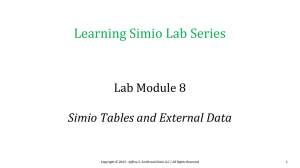
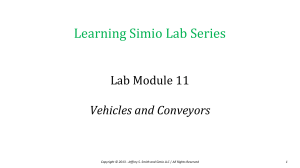
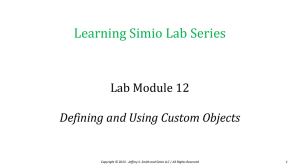
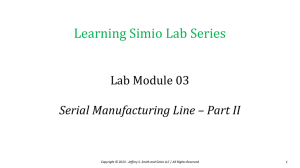
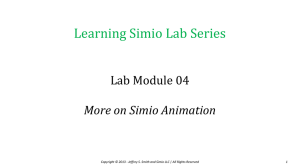

![Your_Solutions_LLC_-_New_Business3[1]](http://s2.studylib.net/store/data/005544494_1-444a738d95c4d66d28ef7ef4e25c86f0-300x300.png)

